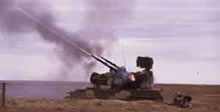Further enhancement of the integrated air defense systems approach is the layered air defense concept, which encompasses various systems into an integrated “near zero leak” air defense. The layered air defense system protects a site by defeating multiple attacks of various types of armaments. Layered air defense systems usually consist of three tiers – the extended range combat layer, where short to medium range missiles engage targets such as attack aircraft and unmanned platforms flying at medium to high altitude, and attack aircraft or cruise missiles flying at a low to very low level. The systems operated at this layer must retain “look-down/shoot-down” operating capability, by screening targets against ground clutter. This capability should be provided both to the sensors, guidance systems and weapon systems. This protection level should also be able to engage enemy combat support elements, such as electronic surveillance and target designators.
The second “close-in” combat layer, which employs radar controlled guns and Very SHO Range Air Defense missiles (VSHORAD) missiles, such as SA-7/14/18, Stinger and Mistral, should also provide anti-missile protection. These weapons should target the precision strike weapons which, having penetrated the first layer, are threatening the defended site. Typical targets engaged at this level are guided weapons, UAVs, unmanned attack vehicles and gunship helicopters. A mix of systems is appropriate at this level. Most missiles are effective against aircraft and helicopters, while advanced automatic, air defense guns could be efficient against guided weapons, when equipped with advanced systems such as the Russian Tungushka or Swiss AHEAD technology.
The integrated gun-missile systems (such as Tunguska and Pantsir) offer an impressive capability, especially for point and tactical mobile air defense. However, even with their formidable firepower, such systems cannot act independently. Some analysts are questioning the claimed effectiveness of the 30mm gun at maximum range (3,000 – 4,000 meters), where its capability against small targets (missiles guided weapons and helicopters) is questionable, as kill probability drops well below 50%. With such low yield, the air defense vehicle has an inherent “dead zone” at ranges between 1,500 – 2,500 m’, where the hit probability of the gun drops sharply and the missile cannot engage the target. Therefore, mutual coverage of firing units should be employed to eliminate this deficiency.
The progress of modern air defense systems is being augmented by the modernization of active, passive and networked air defense sensors.
Additional parts of this article:
- Mobile Short Range Air Defense Systems
- Modern Air Defense Concepts
- SHORAD Transformation
- Net Centric Air Defense Systems
















